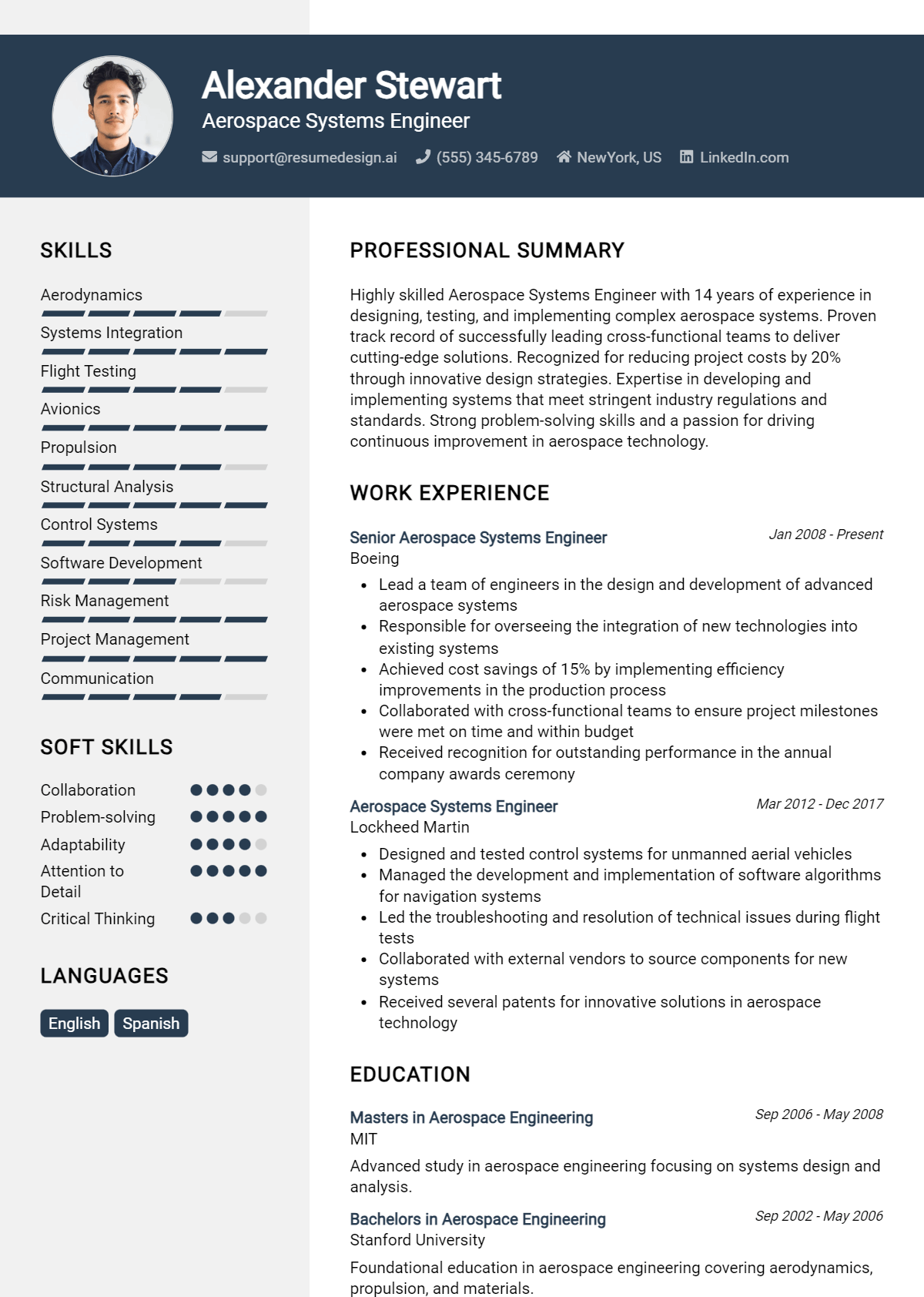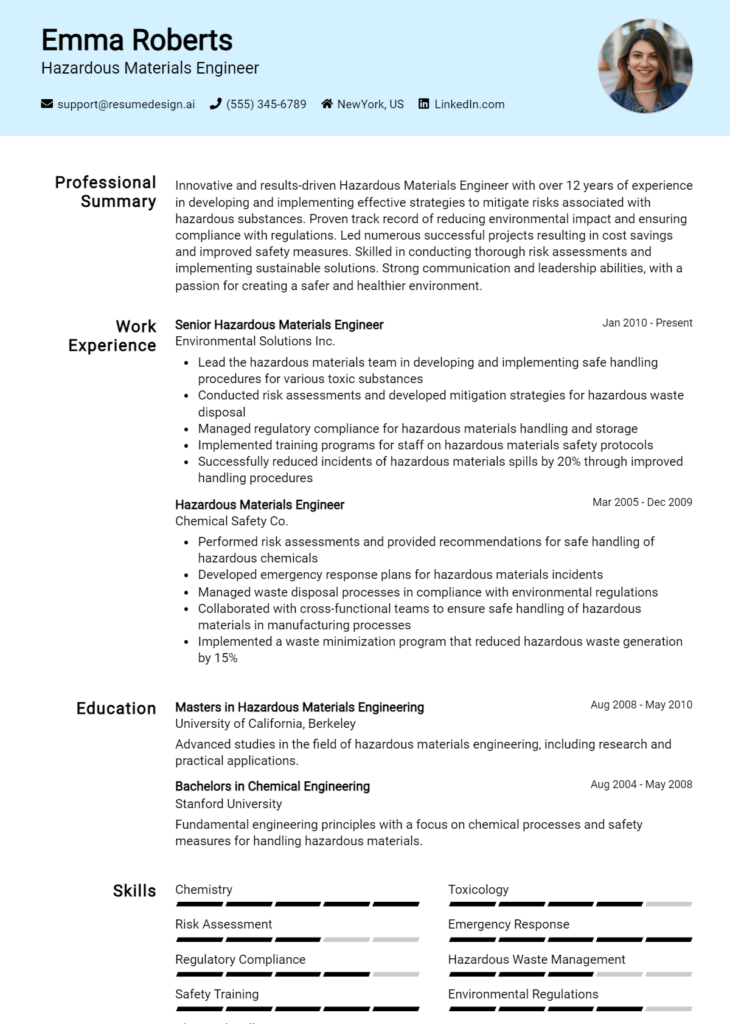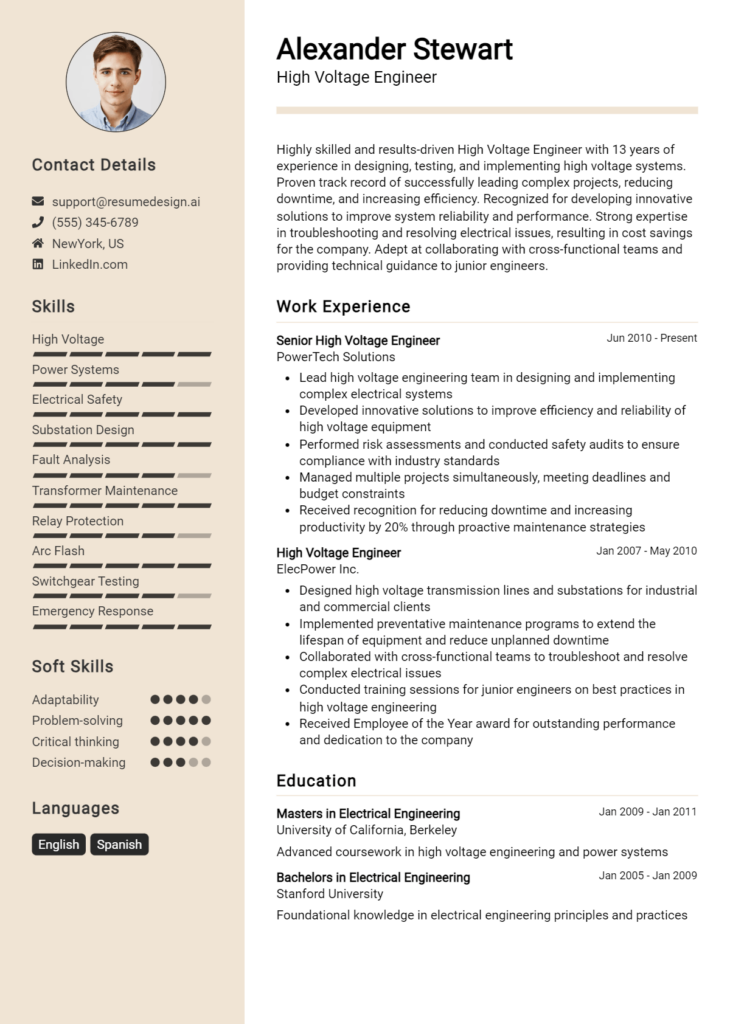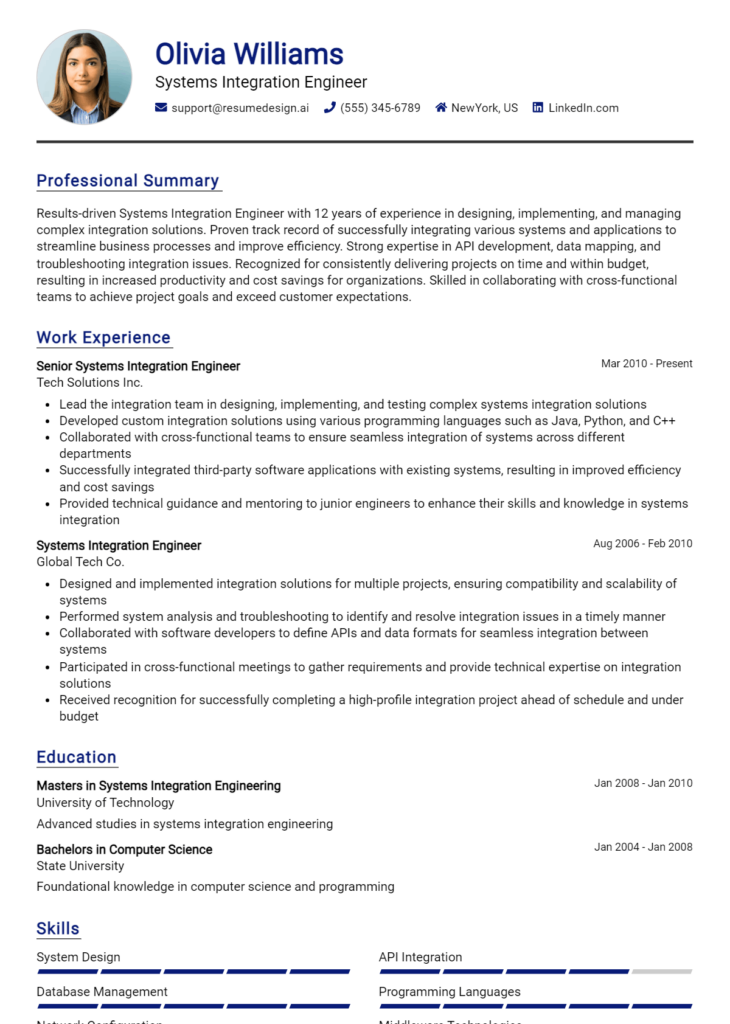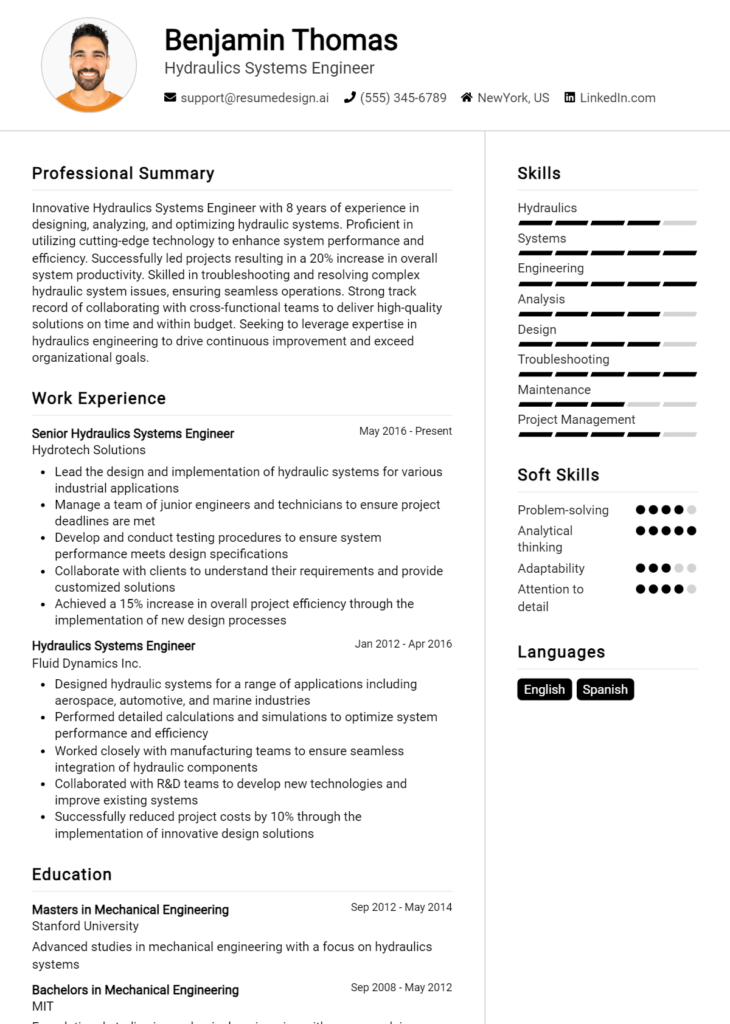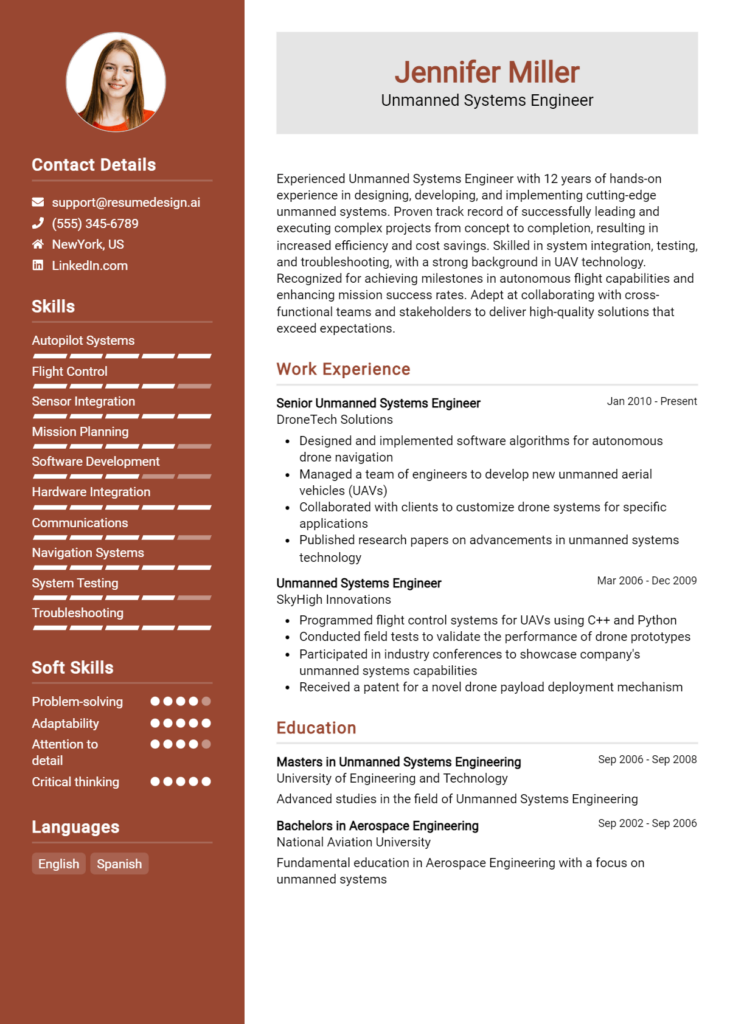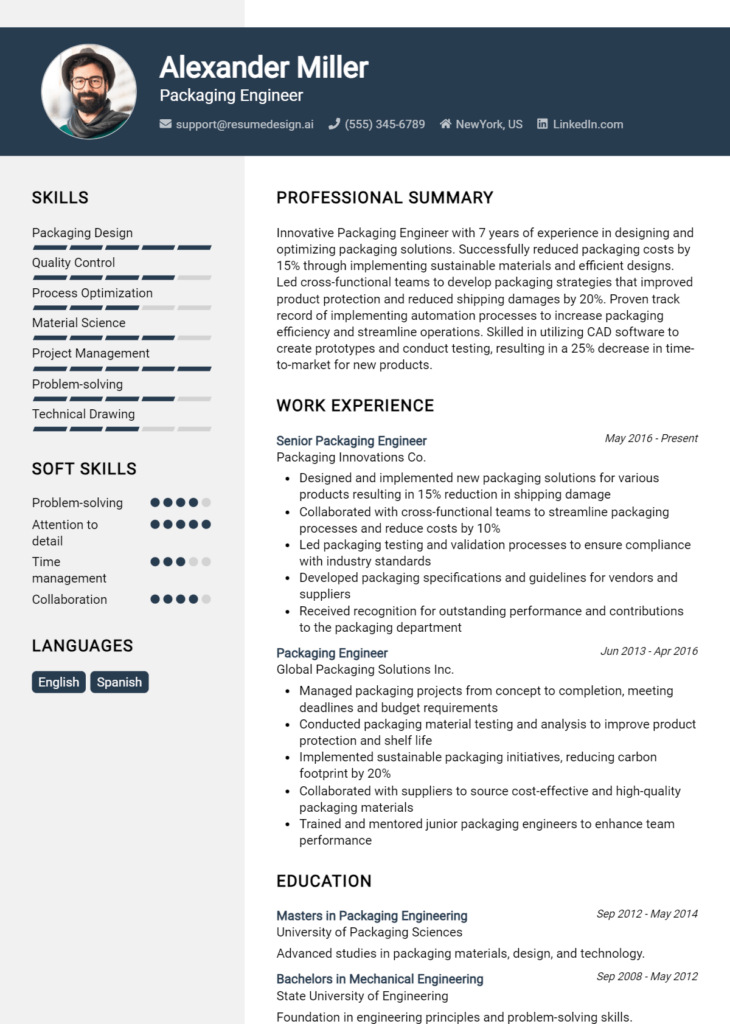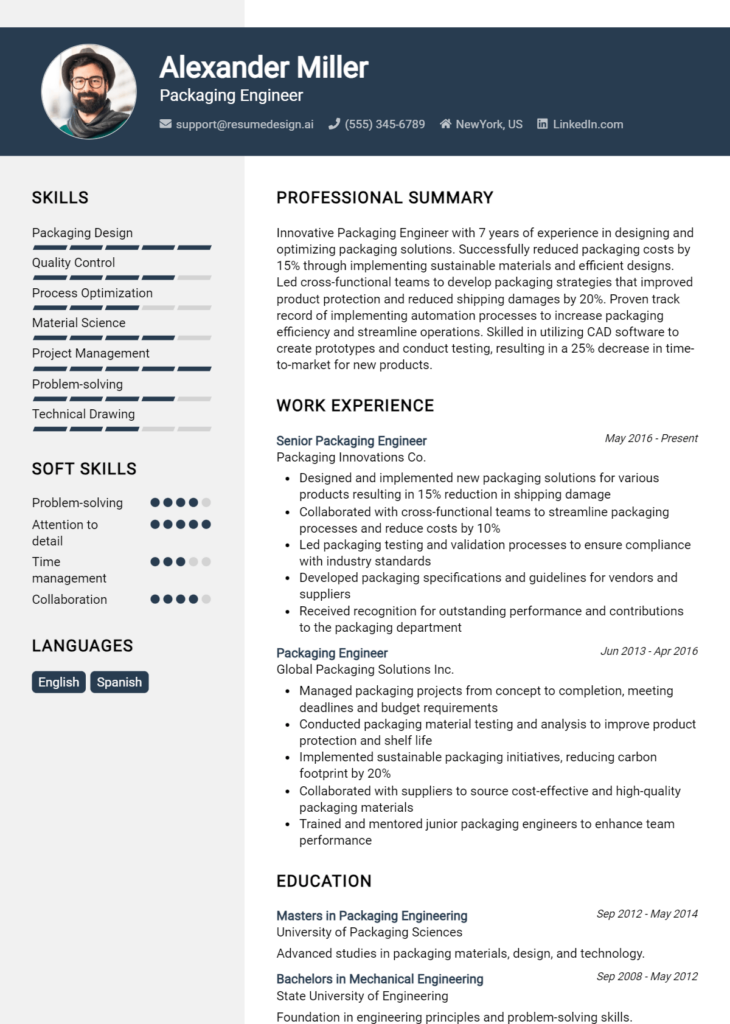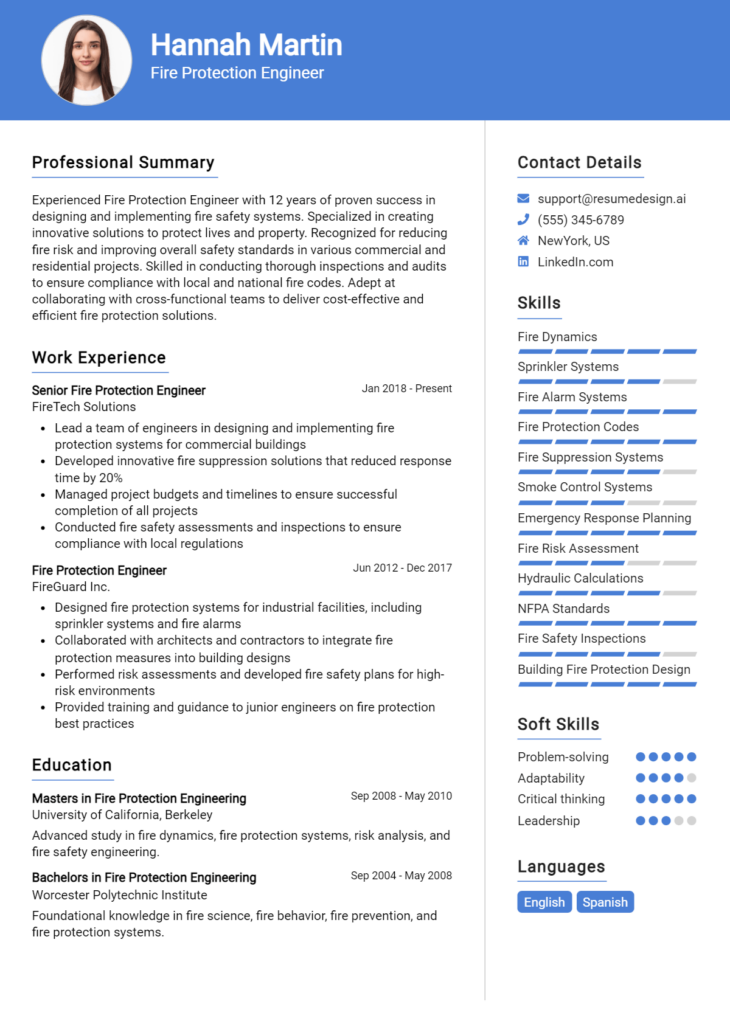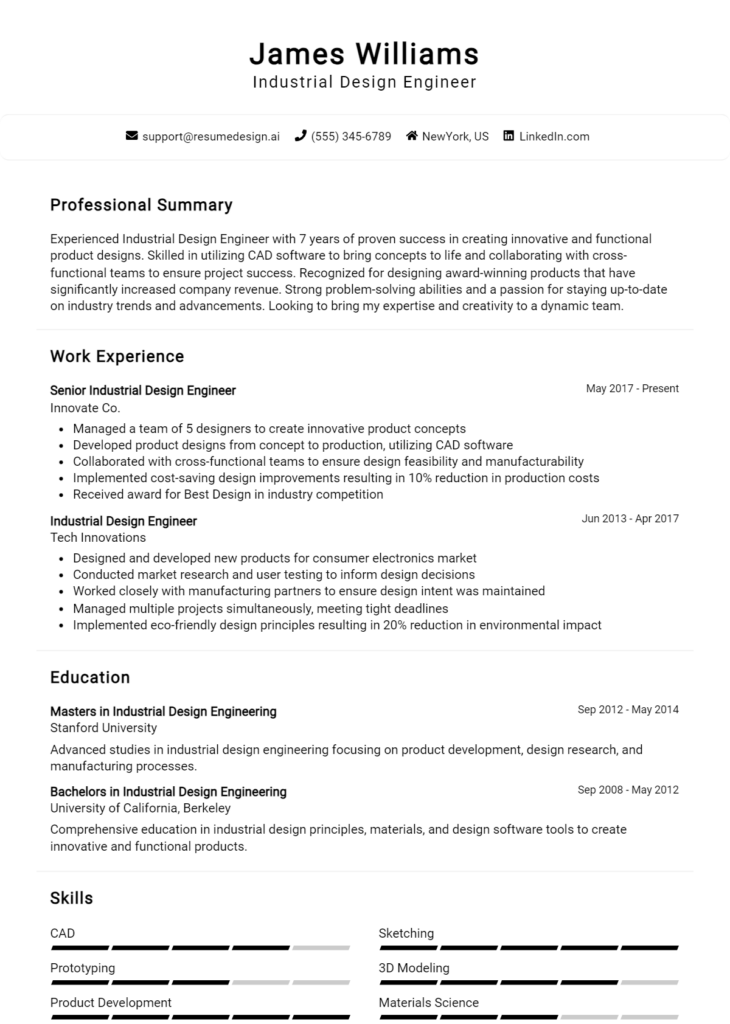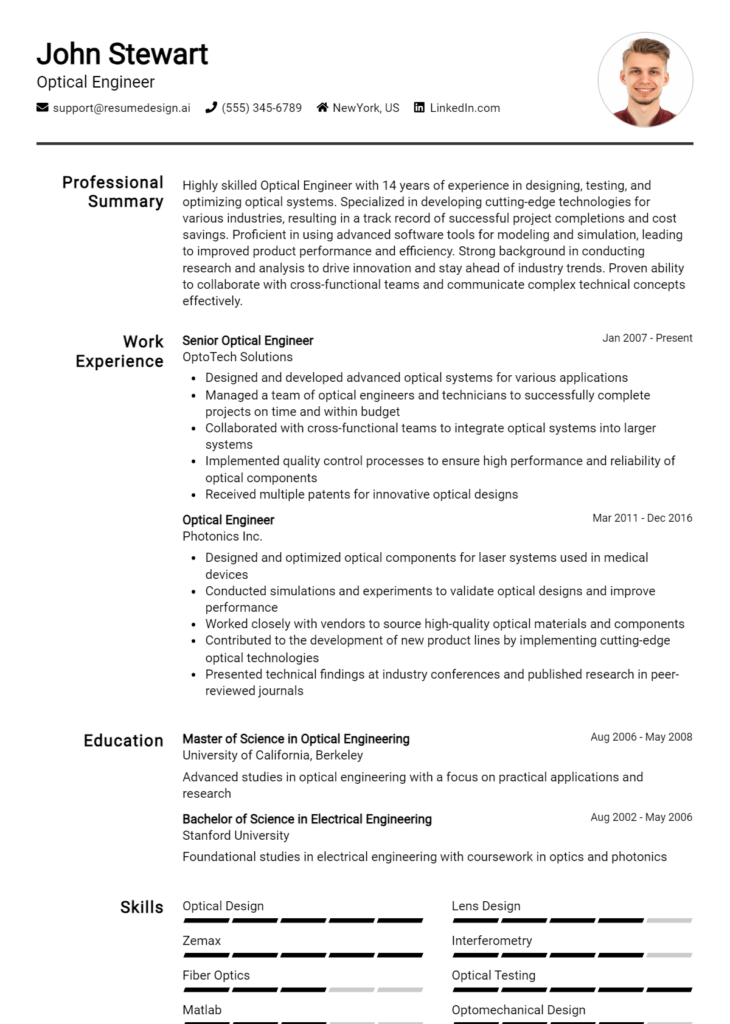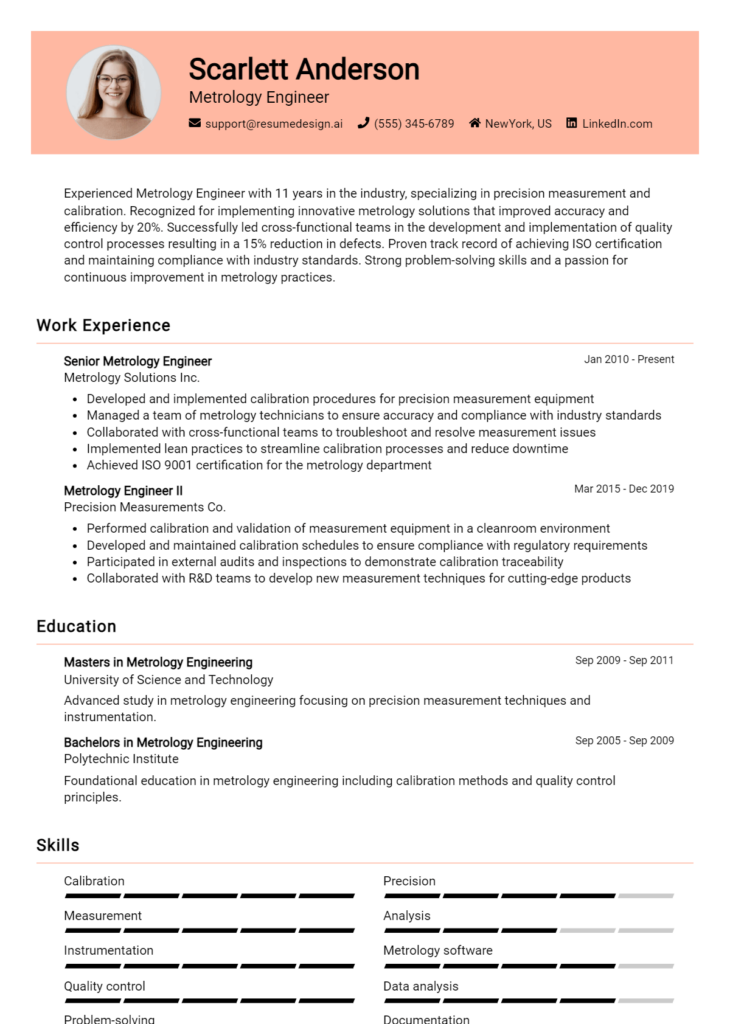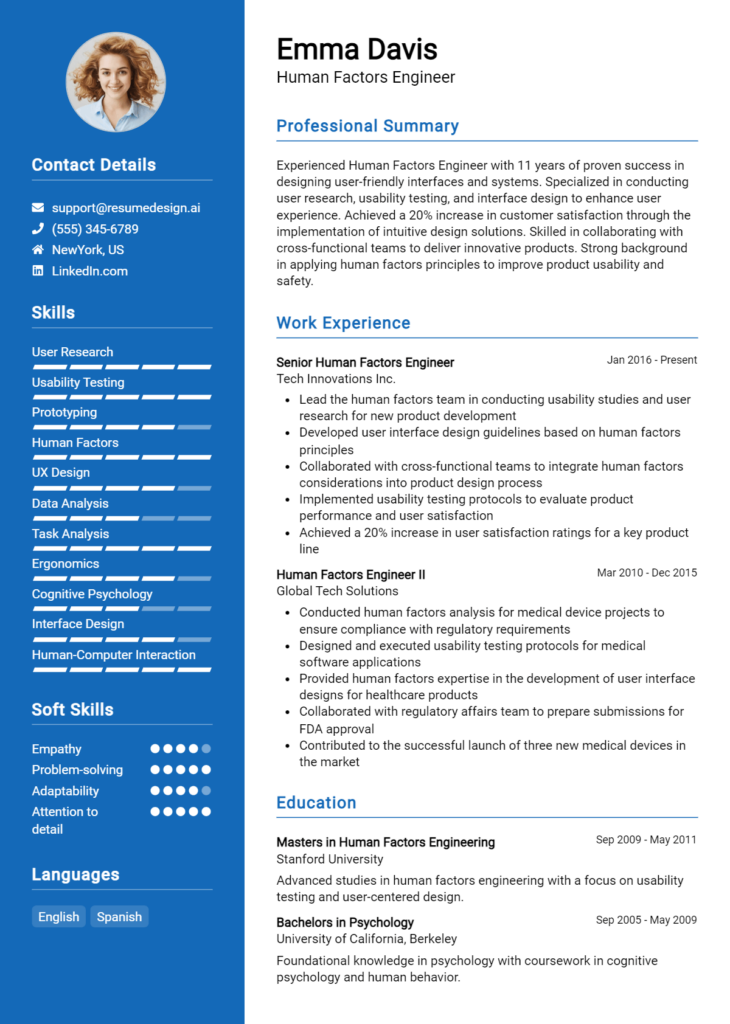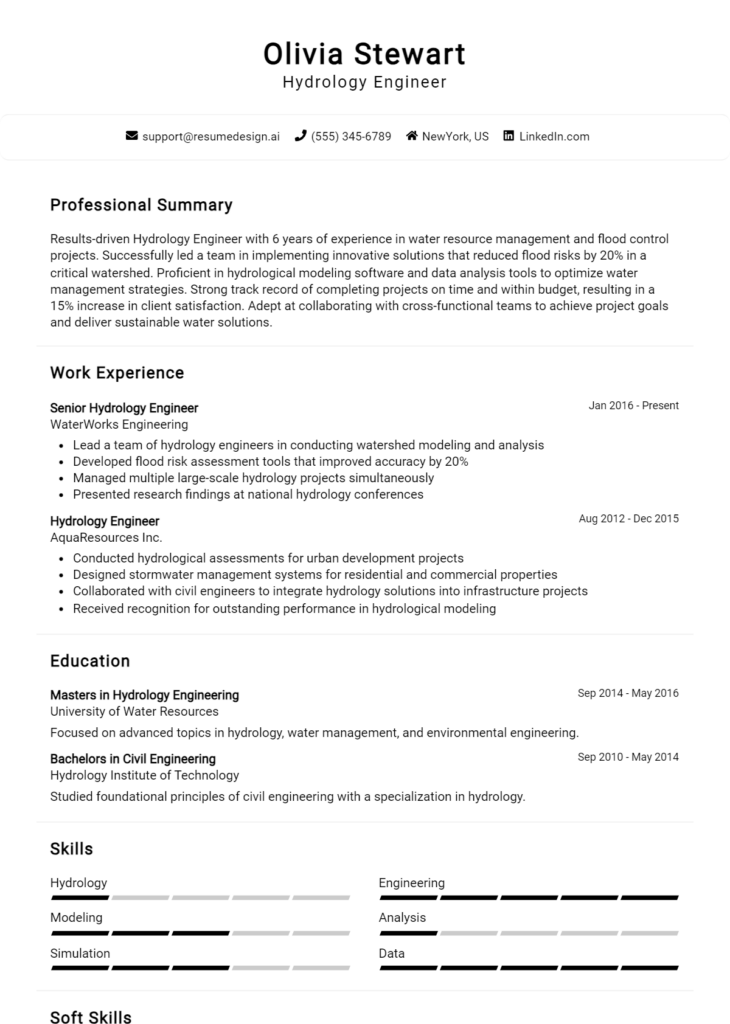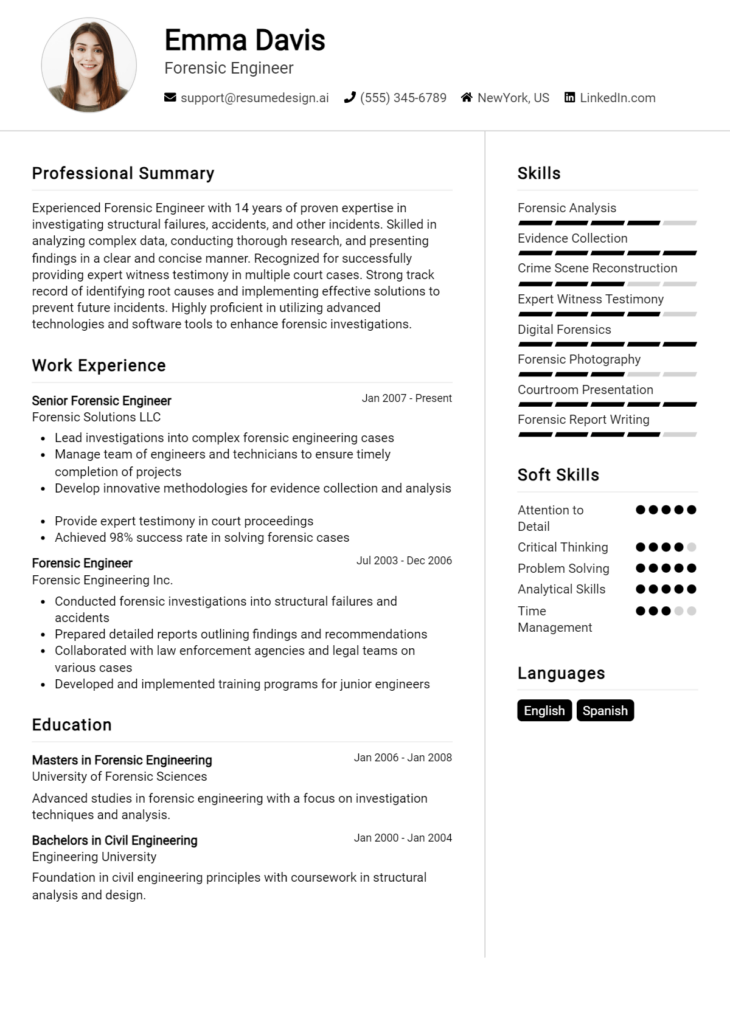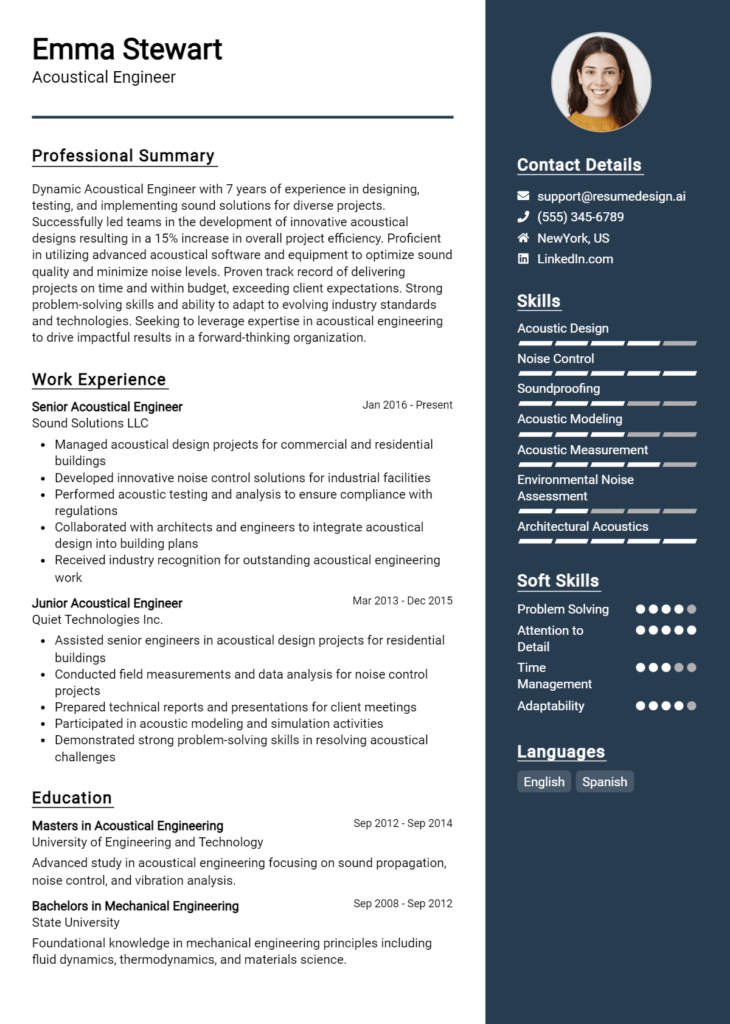Aerospace Systems Engineer Core Responsibilities
An Aerospace Systems Engineer plays a pivotal role in the design, development, and integration of complex aerospace systems. This professional collaborates across various departments, such as design, testing, and production, ensuring seamless communication and coordination. Key responsibilities include analyzing system requirements, conducting risk assessments, and implementing solutions to technical challenges. Strong analytical, operational, and problem-solving skills are essential to meet organizational goals. A well-structured resume that highlights these competencies can significantly enhance job prospects in this competitive field.
Common Responsibilities Listed on Aerospace Systems Engineer Resume
- Conduct system-level analysis and design of aerospace systems.
- Collaborate with cross-functional teams to ensure project alignment.
- Develop and document technical specifications and requirements.
- Perform risk assessment and mitigation planning.
- Oversee testing and validation of aerospace components and systems.
- Utilize modeling and simulation tools for system performance evaluation.
- Ensure compliance with industry standards and regulations.
- Support troubleshooting and problem resolution during project execution.
- Prepare and present technical reports to stakeholders.
- Manage project timelines and deliverables effectively.
- Engage in continuous improvement initiatives for aerospace systems.
High-Level Resume Tips for Aerospace Systems Engineer Professionals
In the competitive field of aerospace engineering, a well-crafted resume is crucial for making a strong first impression on potential employers. Your resume serves as your professional introduction, showcasing not only your technical skills and expertise but also your unique achievements and contributions to the industry. Given the complexity and specificity of aerospace systems engineering, it is essential that your resume effectively reflects your qualifications and aligns with the expectations of hiring managers. This guide will provide practical and actionable resume tips specifically tailored for Aerospace Systems Engineer professionals, ensuring you stand out in a crowded job market.
Top Resume Tips for Aerospace Systems Engineer Professionals
- Tailor your resume to the job description by incorporating relevant keywords and phrases that reflect the requirements of the position.
- Highlight your experience in aerospace projects, focusing on your role, responsibilities, and the outcomes achieved.
- Quantify your achievements where possible, using metrics to demonstrate the impact of your work, such as cost savings, efficiency improvements, or successful project completions.
- Showcase your technical skills relevant to aerospace systems, including software proficiency (e.g., MATLAB, CATIA) and knowledge of industry standards (e.g., DO-178C, AS9100).
- Include certifications and licenses that are pertinent to the aerospace field, such as Engineer in Training (EIT) or Professional Engineer (PE) status.
- Utilize a clear and professional format that enhances readability, making it easy for hiring managers to identify key information quickly.
- Incorporate a summary statement at the top of your resume that succinctly outlines your career goals and core competencies.
- List relevant coursework or projects from your education that align with aerospace systems engineering principles and practices.
- Network references or endorsements from past employers or colleagues in the aerospace industry to bolster your credibility.
By implementing these tips, you can significantly enhance your resume and increase your chances of landing a job in the Aerospace Systems Engineer field. A strategically crafted resume not only highlights your skills and experiences but also positions you as a strong candidate who meets the specific needs of potential employers, ultimately opening doors to exciting career opportunities in aerospace engineering.
Why Resume Headlines & Titles are Important for Aerospace Systems Engineer
In the competitive field of aerospace engineering, a well-crafted resume headline or title serves as a crucial first impression for job seekers applying for positions as Aerospace Systems Engineers. This brief yet powerful phrase can immediately capture the attention of hiring managers, summarizing a candidate's key qualifications, skills, and career achievements in a concise manner. A strong headline not only highlights what the applicant brings to the table but also sets the tone for the rest of the resume. It should be relevant to the specific job being applied for, ensuring that it resonates with the hiring team and showcases the candidate's suitability for the role.
Best Practices for Crafting Resume Headlines for Aerospace Systems Engineer
- Keep it concise—aim for one impactful phrase or sentence.
- Make it role-specific by including relevant job titles or keywords.
- Highlight key skills or areas of expertise that align with the job description.
- Use strong action words to convey a sense of accomplishment and capability.
- Incorporate industry-specific terminology to demonstrate familiarity with the field.
- Avoid jargon or overly complex language that may confuse the reader.
- Ensure it reflects your unique value proposition as a candidate.
- Tailor the headline for each application, adjusting it to fit the specific job requirements.
Example Resume Headlines for Aerospace Systems Engineer
Strong Resume Headlines
Dynamic Aerospace Systems Engineer with 10+ years of experience in avionics and systems integration.
Innovative Aerospace Engineer Specializing in Unmanned Aerial Vehicle Development and Flight Testing.
Results-Driven Aerospace Systems Engineer with Proven Track Record in Project Management and Team Leadership.
Weak Resume Headlines
Engineer Looking for Opportunities in Aerospace.
Aerospace Systems Engineer with Some Experience.
The strong resume headlines are effective because they are specific, highlighting the candidate's experience and areas of expertise while using powerful language that conveys confidence and capability. In contrast, the weak headlines fail to impress due to their vagueness and lack of detail, leaving hiring managers without a clear understanding of what makes the candidate a strong fit for the position. By focusing on clarity and relevance, strong headlines can create a compelling narrative that encourages employers to read further.
Writing an Exceptional Aerospace Systems Engineer Resume Summary
A resume summary is a vital component for an Aerospace Systems Engineer, as it serves as a concise introduction that captures the attention of hiring managers. A well-crafted summary highlights the candidate's key skills, relevant experience, and notable accomplishments, providing a snapshot of what they bring to the table. In an industry where precision and expertise are paramount, a strong summary should be impactful and tailored specifically to the job being applied for, allowing candidates to stand out in a competitive field.
Best Practices for Writing a Aerospace Systems Engineer Resume Summary
- Quantify achievements where possible, using metrics to demonstrate impact.
- Focus on key skills that are directly relevant to the aerospace engineering field.
- Tailor the summary to align with the specific job description and requirements.
- Use clear and concise language to communicate your value quickly.
- Highlight relevant experience, including project involvement and leadership roles.
- Incorporate industry-specific terminology to showcase your expertise.
- Avoid generic statements and focus on unique contributions and results.
- Keep it to 2-4 sentences for brevity while maintaining substance.
Example Aerospace Systems Engineer Resume Summaries
Strong Resume Summaries
Driven Aerospace Systems Engineer with over 8 years of experience in designing and testing advanced avionic systems, resulting in a 20% reduction in system failures. Proficient in MATLAB and Simulink, with a track record of leading cross-functional teams to successful project deliveries ahead of schedule.
Results-oriented Aerospace Systems Engineer with a strong background in propulsion systems. Successfully led a team to develop a new fuel efficiency model that improved performance by 15%, contributing to a $1 million savings in operational costs. Excellent problem-solving skills and a commitment to innovative engineering solutions.
Detail-oriented Aerospace Systems Engineer with expertise in systems integration and compliance. Spearheaded a project that achieved 100% regulatory compliance for a new aircraft model, reducing inspection time by 30%. Skilled in project management and stakeholder collaboration.
Weak Resume Summaries
Aerospace Systems Engineer with some experience in various projects. Looking for a challenging role in the aerospace industry.
Dedicated engineer with a passion for aerospace systems. Interested in opportunities to contribute to engineering projects.
The strong resume summaries are considered effective because they provide specific details about the candidate's accomplishments and skills, including quantifiable results that illustrate their impact in previous roles. They demonstrate a clear alignment with the aerospace engineering field and the job specifications. In contrast, the weak summaries are vague and lack measurable achievements or specific skills, making them less engaging and informative for hiring managers.
Work Experience Section for Aerospace Systems Engineer Resume
The work experience section of an Aerospace Systems Engineer resume is a critical component that demonstrates the candidate's technical skills, project management capabilities, and commitment to delivering high-quality aerospace products. This section not only outlines past roles and responsibilities but also highlights achievements that are quantifiable and relevant to the aerospace industry. By aligning experiences with industry standards, candidates can effectively showcase their proficiency in handling complex engineering challenges, leading teams, and contributing to successful project outcomes, making them more attractive to potential employers.
Best Practices for Aerospace Systems Engineer Work Experience
- Focus on technical skills relevant to aerospace systems, such as systems design, analysis, and simulation.
- Quantify achievements with specific metrics, such as cost savings, performance improvements, or project timelines.
- Highlight leadership roles and team management experiences to demonstrate collaborative capabilities.
- Use industry-specific terminology and standards to align experiences with employer expectations.
- Include successful project outcomes that illustrate problem-solving skills and innovation.
- Tailor work experience descriptions to match the job description, emphasizing relevant experiences.
- Showcase any interdisciplinary work that involves collaboration with other engineering fields.
- Keep descriptions concise and impactful, using active language to convey ownership of projects.
Example Work Experiences for Aerospace Systems Engineer
Strong Experiences
- Led a cross-functional team that developed a new aircraft control system, resulting in a 20% improvement in fuel efficiency and a 15% reduction in development costs.
- Implemented a rigorous testing protocol for a satellite communication system, achieving a 99.9% reliability rate, which contributed to a successful launch.
- Managed a $5 million aerospace project, completing it three months ahead of schedule while maintaining compliance with all regulatory standards.
- Collaborated with software engineers to design and integrate a real-time monitoring system, enhancing operational safety by 30% during flight tests.
Weak Experiences
- Worked on various aerospace projects without specific outcomes or details.
- Assisted in team meetings and contributed ideas occasionally.
- Involved in the development of engineering processes, but did not specify any measurable impact.
- Performed routine testing on systems without highlighting any results or improvements.
The examples provided illustrate a clear distinction between strong and weak experiences in an Aerospace Systems Engineer's resume. Strong experiences are characterized by specific, quantifiable achievements that demonstrate technical expertise, leadership, and successful collaboration on significant projects. In contrast, weak experiences lack detail and measurable outcomes, making it challenging for potential employers to gauge the candidate's true impact and capabilities in the aerospace field.
Education and Certifications Section for Aerospace Systems Engineer Resume
The education and certifications section of an Aerospace Systems Engineer resume plays a crucial role in establishing the candidate's qualifications and expertise in a highly specialized field. This section not only highlights the academic background of the candidate but also showcases industry-relevant certifications and ongoing learning efforts. By providing detailed information about relevant coursework, certifications, and specialized training, candidates can significantly enhance their credibility and demonstrate alignment with the requirements of the job role. A well-structured education and certifications section can set a candidate apart in a competitive job market, showcasing their commitment to professional development and deep understanding of aerospace systems engineering principles.
Best Practices for Aerospace Systems Engineer Education and Certifications
- Prioritize relevant degrees, such as aerospace engineering, mechanical engineering, or systems engineering.
- Include industry-recognized certifications, such as Certified Systems Engineering Professional (CSEP) or Project Management Professional (PMP).
- List any specialized training or workshops that align with aerospace systems engineering practices.
- Provide details about relevant coursework that demonstrates knowledge in key areas like aerodynamics, propulsion systems, or systems integration.
- Highlight advanced degrees (e.g., Master’s or Ph.D.) to showcase depth of knowledge and research capabilities.
- Keep the section organized, using clear headings and bullet points for easy readability.
- Use specific course names or certification titles rather than general terms to provide clarity on expertise.
- Update the section regularly to reflect new qualifications or relevant training that enhances your skill set.
Example Education and Certifications for Aerospace Systems Engineer
Strong Examples
- Bachelor of Science in Aerospace Engineering, Massachusetts Institute of Technology, 2020
- Certified Systems Engineering Professional (CSEP), INCOSE, 2022
- Project Management Professional (PMP), Project Management Institute, 2021
- Relevant Coursework: Advanced Aerodynamics, Control Systems Engineering, and Propulsion Fundamentals
Weak Examples
- Associate Degree in General Studies, Community College, 2018
- Certification in Microsoft Office Suite, 2019
- Bachelor of Arts in History, University of California, 2017
- Outdated coursework in Basic Mathematics and Algebra
The strong examples demonstrate a direct alignment with the aerospace systems engineering role, showcasing relevant degrees, certifications, and coursework that enhance a candidate's qualifications. These credentials reflect a commitment to the field and a strong foundation in essential skills. In contrast, the weak examples highlight irrelevant or outdated qualifications that do not contribute to the candidate's suitability for the position. Such entries could confuse prospective employers and detract from the overall impression of the candidate's expertise in aerospace systems engineering.
Top Skills & Keywords for Aerospace Systems Engineer Resume
As an Aerospace Systems Engineer, showcasing the right skills on your resume is crucial for capturing the attention of potential employers. The aerospace industry demands a unique blend of technical proficiency and interpersonal abilities, making it essential to highlight both hard and soft skills effectively. Employers look for candidates who can navigate complex systems, collaborate with multidisciplinary teams, and drive innovative solutions. Including a comprehensive list of skills not only reflects your qualifications but also demonstrates your readiness to tackle the challenges of this dynamic field. For more information on how to enhance your resume, visit our skills section.
Top Hard & Soft Skills for Aerospace Systems Engineer
Soft Skills
- Communication skills
- Teamwork and collaboration
- Problem-solving ability
- Critical thinking
- Adaptability
- Attention to detail
- Leadership skills
- Time management
- Conflict resolution
- Creativity and innovation
Hard Skills
- Systems engineering principles
- Aerospace design and analysis
- MATLAB/Simulink proficiency
- CAD software (e.g., CATIA, SolidWorks)
- Requirements analysis
- Risk management techniques
- Project management methodologies
- Familiarity with aerospace regulations (e.g., FAA, EASA)
- Software development and coding (e.g., C++, Python)
- Knowledge of propulsion systems
Incorporating these skills into your resume can significantly enhance your job prospects in the aerospace sector. Additionally, making sure to detail your work experience will further support your qualifications and demonstrate your capability to excel in this role.
Stand Out with a Winning Aerospace Systems Engineer Cover Letter
As a dedicated Aerospace Systems Engineer with over five years of experience in the design and analysis of complex aerospace systems, I am excited to apply for the position at [Company Name]. My background in developing innovative solutions for flight systems, coupled with my strong analytical skills, aligns perfectly with the goals of your engineering team. I am eager to contribute my expertise in systems engineering principles, requirements management, and verification and validation processes to support the advancement of [specific project or technology mentioned in the job description].
In my previous role at [Previous Company Name], I led a cross-functional team in the design and implementation of a next-generation avionics system. This project not only honed my technical skills in systems integration and performance analysis but also taught me the importance of collaborative problem-solving and effective communication. I successfully coordinated with stakeholders from various disciplines, ensuring that project milestones were met while maintaining the highest standards of safety and compliance. My ability to bridge the gap between technical specifications and user requirements has consistently resulted in innovative solutions that enhance system performance and reliability.
I am particularly drawn to the opportunity at [Company Name] because of your commitment to pioneering aerospace technologies that push the boundaries of what is possible. I am excited about the prospect of working on [specific project or product mentioned], as I believe my experience in [relevant experience or technology] will allow me to make a meaningful impact on your team. Furthermore, I am passionate about continuous learning and staying abreast of industry advancements, which I believe is essential in the rapidly evolving aerospace sector.
Thank you for considering my application. I am looking forward to the possibility of discussing how my skills and experiences align with the needs of your team. I am eager to bring my unique background in aerospace systems engineering to [Company Name], and I am confident that my contributions will help drive innovative solutions and enhance project outcomes.
Common Mistakes to Avoid in a Aerospace Systems Engineer Resume
When crafting a resume for an Aerospace Systems Engineer position, it's essential to present your qualifications and experience effectively. However, many candidates make common mistakes that can detract from their overall appeal to potential employers. Avoiding these pitfalls can significantly enhance your chances of landing an interview. Here are some common mistakes to be aware of:
Overloading with Technical Jargon: While technical skills are crucial in aerospace engineering, excessive jargon can alienate hiring managers who may not be familiar with specific terms. Strive for a balance between technical accuracy and clear communication.
Neglecting Soft Skills: Aerospace Systems Engineers often work in teams and need strong communication and problem-solving skills. Failing to highlight these soft skills can make your resume seem one-dimensional.
Lack of Quantifiable Achievements: Simply listing responsibilities without showcasing your impact can weaken your resume. Use metrics and specific examples to demonstrate your accomplishments, such as improved efficiency or cost savings.
Using a Generic Template: A cookie-cutter resume fails to stand out. Customize your resume for each application to reflect the specific skills and experiences that align with the job description.
Ignoring Formatting Consistency: A visually appealing and well-organized resume is easier to read. Inconsistent fonts, sizes, or bullet points can create a chaotic appearance and distract from your qualifications.
Omitting Relevant Keywords: Many companies use Applicant Tracking Systems (ATS) to filter resumes. Failing to include relevant industry keywords can lead to your resume being overlooked. Tailor your resume to include these keywords based on the job posting.
Excessive Length: While it’s important to be thorough, a resume that is too long can overwhelm readers. Aim to keep your resume concise—ideally one page for less experienced candidates and no more than two pages for seasoned professionals.
Inadequate Proofreading: Typos and grammatical errors can signal a lack of attention to detail, which is critical in aerospace engineering. Always proofread your resume or have someone review it to catch mistakes before you submit it.
Conclusion
As we conclude our exploration of the Aerospace Systems Engineer role, it's essential to reflect on the diverse skill set and responsibilities that define this position. Key aspects include proficiency in system design, integration, testing, and the ability to work collaboratively across multidisciplinary teams. Aerospace Systems Engineers must also stay updated on industry standards and advancements in technology to ensure the safety and efficiency of aerospace systems.
Considering the competitive nature of the aerospace industry, having a well-crafted resume is crucial for showcasing your qualifications effectively. We encourage you to take a moment to review and enhance your Aerospace Systems Engineer resume. Utilize available resources to ensure your application stands out.
Check out these helpful tools:
- Resume Templates to find a layout that fits your style.
- Resume Builder for a step-by-step guide in creating a professional resume.
- Resume Examples to inspire and guide your content.
- Cover Letter Templates that can complement your application and highlight your enthusiasm for the role.
Take charge of your career today by refining your resume!

